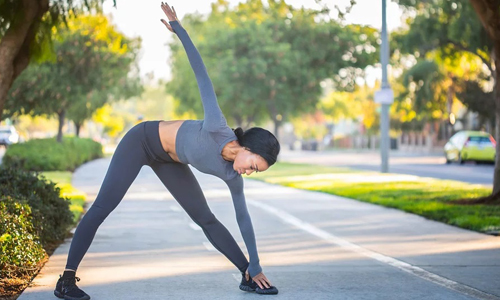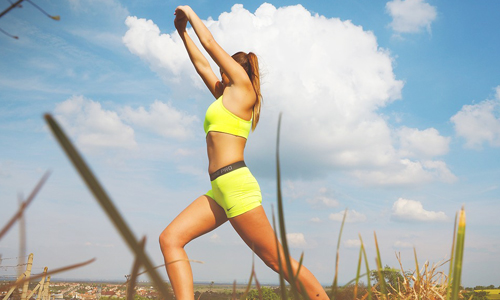Static Stretching V/s Dynamic Stretching: A Runner’s Guide
Warm up or stretching before indulging in any aerobic or gymnastic activity is very common, precisely because it is a very helpful and effective injury-prevention habit. Those who follow this before their daily aerobic routine or those who don’t will surely find some useful information as they read ahead. However, doing the correct form of stretching is the key. Dynamic stretching is meant to be done before running, while static stretching is meant to be done after running or any aerobic activity. Let us delve in to the details to find out more.
What Does Dynamic Stretching Mean?
This is a form of stretching while in motion as opposed to the static stretching. It puts the key muscles through a full range of active motion. These stretches are a part of every runner’s comprehensive warm-up routine. Some of the examples are:
The Fluid Hamstring Stretch
Lean forward and stabilize your body with your fingers or hand against the ground and let one leg naturally rise. This stretch is felt in the hamstring of the balancing leg. Do not push too hard or lock your knees but make it a light and fluid stretch. Hold for a couple of seconds on each leg and repeat at least 8-10 times.
Walk Doing the Quad
The quad stretch requires for you to pull your heel up while either walking forward or standing still. Switch legs every few seconds, 8- 10 times for each leg.
Flex Your Hips
The Hip Flexor stretch requires you to hold one of your legs against your chest and waiting a few seconds before switching it with the other leg. Repeat 8-10 times for each leg while either walking forward or standing.
Do the Leg Swing
To perform this dynamic stretch, you need to find a fence or an object to stabilize your body as you place your hand on it. Once your body is balanced, gently swing the inside leg back and forth while holding out your arm. For a hip opener, face the wall and swing your legs side to side. Do this at least 8-10 times on each leg.
What Does Static Stretching Mean?
As the name suggests, Static stretching is stretching while holding still. Since the muscles are held still while static stretching, it becomes more useful after running rather than before it. Some of the examples are:
The Glute Stretch in Static Position
This stretching position helps you open your hips and stretch the glutes. It is often referred to as the pigeon pose as it requires for you to cross one leg in front of you and easily stretch your other leg straight behind you.
Do the High Lunge
As you get into the lunge position, instead of bringing your front foot toward your chest. Place it to the outside of your arm. This slight change is helpful for opening tightened hips, which is often the case with runners.
The All-Round Muscle Exercise
For good muscle exercise, do the static calf and hamstring stretch. Straighten one of your legs in front of you with the heel touching the ground, while resting your balance on the other knee and touch the ground with your fingertips.
So, now that you are aware of what was lacking in your warm-ups and post-run stretching, following these tips about stretches might help you with decreasing the risks of muscle pulls and injury while in action.
Categories
- Sport (28)
- Product Reviews (3)
- Team Outdoor Look (7)
- Mike Wild (2)
- Mike Payton (2)
- Suse Hammond-Pears (3)
- Snowboarding (12)
- Latest Offers (105)
- Shop Talk (1)
- Competitions (7)
- Walking (413)
- Lifestyle Fashion (8)
- Travel (86)
- Kit Guides (176)
- Workwear Clothing (6)
- Safety Workwear (4)
- Health/Fitness (289)
- Skiing (91)
- Great Outdoors (1316)
- Cycling (92)
- January 2025
- December 2024
- November 2024
- October 2024
- September 2024
- August 2024
- July 2024
- June 2024
- May 2024
- April 2024
- March 2024
- February 2024
- January 2024
- December 2023
- November 2023
- October 2023
- September 2023
- August 2023
- July 2023
- June 2023
- May 2023
- April 2023
- March 2023
- February 2023
- January 2023
- December 2022
- November 2022
- October 2022
- September 2022
- August 2022
- July 2022
- June 2022
- May 2022
- April 2022
- March 2022
- February 2022
- January 2022
- December 2021
- November 2021
- October 2021
- September 2021
- August 2021
- July 2021
- June 2021
- May 2021
- April 2021
- March 2021
- February 2021
- January 2021
- December 2020
- November 2020
- October 2020
- September 2020
- August 2020
- July 2020
- June 2020
- May 2020
- April 2020
- March 2020
- February 2020
- January 2020
- December 2019
- November 2019
- October 2019
- September 2019
- August 2019
- July 2019
- June 2019
- May 2019
- April 2019
- March 2019
- February 2019
- January 2019
- December 2018
- November 2018
- October 2018
- September 2018
- August 2018
- July 2018
- June 2018
- May 2018
- April 2018
- March 2018
- February 2018
- January 2018
- December 2017
- November 2017
- October 2017
- September 2017
- August 2017
- July 2017
- June 2017
- May 2017
- April 2017
- March 2017
- February 2017
- January 2017
- December 2016
- November 2016
- October 2016
- September 2016
- August 2016
- July 2016
- June 2016
- May 2016
- April 2016
- March 2016
- February 2016
- January 2016
- December 2015
- November 2015
- October 2015
- September 2015
- August 2015
- July 2015
- June 2015
- May 2015
- April 2015
- March 2015
- February 2015
- January 2015
- December 2014
- November 2014
- October 2014
- September 2014
- August 2014
- July 2014
- June 2014
- May 2014
- April 2014
- March 2014
- February 2014
- January 2014
- December 2013
- November 2013
- October 2013
- September 2013
- August 2013
- July 2013
- June 2013
- May 2013
- April 2013
- March 2013
- February 2013
- January 2013
- December 2012
- November 2012
- October 2012
- September 2012
- August 2012
- July 2012
- June 2012
- May 2012
- April 2012
- March 2012
- February 2012
- January 2012
- December 2011
- November 2011
- October 2011
- September 2011
- August 2011
- May 2010
- April 2010
- March 2010
- February 2010
- January 2010
- November 2009
- October 2009
- September 2009
Submit a Comment